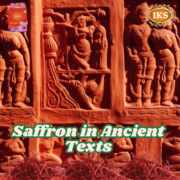Saffron in Ancient Texts: A Journey Through History
Saffron in Ancient Texts: A Journey Through History
Saffron in Ancient Texts – Saffron, the vibrant and aromatic spice, has captivated the imagination of people throughout history. Its rich cultural heritage and enduring presence in ancient texts reveal a fascinating story that transcends time and geography.
In this comprehensive article, we will delve into the ancient roots of saffron, exploring its significance and symbolism across various civilizations and sacred writings.
Unravel the Mysteries of Saffron 🔍 – Explore its Enduring Legacy in the Ancient World
The Saffron Trail: Tracing Its Origins in Ancient Civilizations
The origins of saffron can be traced back to the ancient world, with evidence of its cultivation and use found in various regions.
One of the earliest known references to saffron dates back to the Sumerians, who lived in Mesopotamia around 3500 BCE. The Sumerians revered saffron as a sacred spice, using it in religious ceremonies and as a dye for textiles.
Saffron in Ancient Egypt
In ancient Egypt, saffron held a prominent place in the cultural and medicinal practices of the time. Cleopatra, the legendary queen of Egypt, was said to have used saffron-infused oils and lotions to enhance her beauty and allure.
Saffron was also employed in embalming rituals and as a treatment for various ailments, showcasing its versatility and importance in the ancient Egyptian world.
Saffron in Ancient Greece and Rome
The ancient Greeks and Romans were equally captivated by the allure of saffron. In Greek mythology, the crocus flower, from which saffron is derived, was believed to have sprung from the blood of the youth Crocus, who was transformed into a flower by the gods.
Saffron was used in religious ceremonies, medicine, and as a culinary ingredient, with its distinctive aroma and flavor prized by the ancient Mediterranean civilizations.
Awaken Your Senses! 👃 Learn How Saffron Captivated Ancient Civilizations
Saffron in the Sacred Texts of the East
The significance of saffron extends beyond the ancient Western world, as it is also deeply rooted in the sacred texts and traditions of the East.
Saffron in Ayurvedic Medicine
In the ancient Indian system of Ayurvedic medicine, saffron has been revered for its medicinal properties for thousands of years.
The Vedas, the foundational texts of Hinduism, make numerous references to the use of saffron in various spiritual and healing practices. Saffron was believed to possess a range of therapeutic benefits, from improving digestion and circulation to enhancing mood and cognitive function.
Saffron in Traditional Chinese Medicine
The ancient Chinese also recognized the medicinal value of saffron, with references to its use in traditional Chinese medicine (TCM) dating back to the Han Dynasty (206 BCE–220 CE).
In TCM, saffron was thought to possess the ability to nourish the heart, calm the mind, and promote overall well-being. It was often used in combination with other herbs and minerals to treat a variety of ailments.
Saffron in Islamic Texts
The Islamic world has also celebrated the significance of saffron throughout history. In the Quran, the holy book of Islam, saffron is mentioned as one of the spices that adorns the gardens of Paradise.
Saffron was also used in various religious ceremonies and as a symbol of purity and spirituality in Islamic cultures.
Dive into the Rich History of Saffron 📚 – From Mesopotamia to the Middle East
The Enduring Symbolism of Saffron
Beyond its practical applications, saffron has also held deep symbolic meaning across various cultures and belief systems.
Saffron as a Symbol of Royalty and Wealth
Saffron’s rarity and labor-intensive cultivation process have long associated it with wealth, power, and royalty. In ancient times, only the elite could afford the precious spice, making it a symbol of status and privilege.
Rulers and nobles often used saffron to signify their power and prestige, further solidifying its place in the collective consciousness of the ancient world.
Saffron as a Symbol of Spirituality and Enlightenment
The vibrant hue of saffron has also been closely linked to spiritual and mystical traditions. In Buddhism, the robes worn by monks are often dyed with saffron, representing their commitment to a life of purity, detachment, and enlightenment.
Similarly, in Hinduism, saffron is associated with the color of the sun and is believed to possess the power to purify the mind and soul.
Saffron as a Symbol of Love and Passion
Saffron’s sensual aroma and rich color have also earned it a reputation as a symbol of love, passion, and desire.
In ancient Persian literature, saffron was often used as a metaphor for the intensity of romantic love, with the spice’s ability to dye fabrics and skin serving as a visual representation of the all-consuming nature of human emotions.
Immerse Yourself in the Aromatic World of Saffron 🌍 – Past and Present
Saffron’s Enduring Legacy in the Modern World
Despite the passage of time, the enduring legacy of saffron continues to captivate and inspire people around the world.
Its ancient roots and multifaceted symbolism have ensured that saffron remains a highly sought-after and revered spice in the modern era.
Saffron in Contemporary Cuisine
In the culinary world, saffron has maintained its status as a prized ingredient, adding its distinctive flavor and vibrant hue to a wide range of dishes.
From the saffron-infused paella of Spain to the fragrant saffron rice of Iran, the spice continues to be a staple in the kitchens of many cultures, showcasing its enduring appeal and versatility.
Saffron in the Wellness and Beauty Industries
The ancient medicinal and therapeutic properties of saffron have also found a renewed interest in the modern wellness and beauty industries.
Saffron is now widely used in a variety of supplements, skincare products, and holistic treatments, with proponents touting its ability to support cognitive function, alleviate mood disorders, and promote overall well-being.
Saffron in the Arts and Crafts
The rich cultural heritage of saffron has also left an indelible mark on the arts and crafts of various civilizations.
From the vibrant saffron-dyed textiles of Kashmir to the intricate saffron-infused pottery of Iran, the spice continues to inspire artists and artisans, preserving its place in the creative expression of the human experience.
20 GRAMS PURE ORIGINAL AUTHENTIC IKS KASHMIRI SAFFRON (KESAR) AS MENTIONED IN ANCIENT TEXTS
Conclusion: The Enduring Allure of Saffron
The journey of saffron through the annals of history is a testament to the enduring power of ancient traditions and the human desire to connect with the natural world.
From its humble origins in the ancient civilizations of Mesopotamia, Egypt, and the Mediterranean, to its profound significance in the sacred texts of the East, KESAR has woven itself into the fabric of human culture, transcending time and place.
As we continue to explore and appreciate the rich history and symbolism of this precious spice, we are reminded of the enduring allure of the natural world and the timeless human quest for meaning, spirituality, and the pursuit of the extraordinary.
Kashmir Saffron‘s enduring legacy serves as a poignant reminder that the wisdom and insights of the past can still inspire and enrich our lives in the present, connecting us to the enduring tapestry of human experience.
Cultivate Your Appreciation for Saffron 🌺 – Explore its Significance












Leave a Reply
Want to join the discussion?Feel free to contribute!